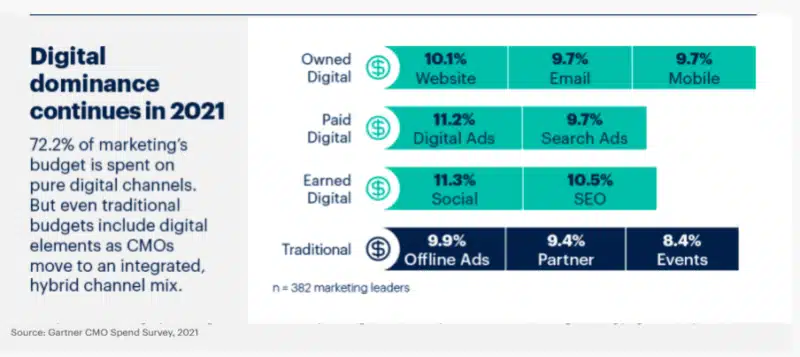Why marketers should embrace product analytics
Product analytics can help marketers optimize digital customer experiences.
“Year over year we’ve seen marketing analytics at the top of marketing budgets,” said John Hurley, Head of Product Marketing at Amplitude, in his recent MarTech session. “It’s a big spend for a lot of teams.”
Marketing analytics tools have been a cornerstone of teams for years, but a changing digital landscape is disrupting this trend. Marketers are placing less emphasis on traditional analytics in favor of operations.
“Marketing analytics actually went from #2 to #4 in the last year,” said Hurley, citing Gartner’s CMO Spend Survey. “But it still makes up a large percentage of where marketing teams are allocating their budgets. Why is it going down?”
To answer this question, Hurley cited another study that found only 27% of senior marketing leaders are satisfied with marketing and data analytics investments. This leaves many marketing organizations scratching their heads, wondering what solutions are available.
New marketing analytics tools for a new era
Digital is dominating marketing spend in this cross-channel environment. And while it’s made some operations easier, it’s also introduced new challenges to the people behind them.
“This adds a level of complexity that I don’t think marketers have fully figured out yet,” said Hurley. “How do we understand how to drive engagement and distribution and allocation of budgets across all of these channels in the right way? How do we orchestrate them? How do we understand attribution across these channels?”
He added, “The shift that we’re seeing is that digital products are becoming the center of digital experiences.”

Know how your customers interact with your advertising today and into the future. Explore the platforms essential to predictive analytics and marketing attribution in the latest edition of this MarTech Intelligence Report.
Digital products fuel digital experiences
Too many marketing organizations treat digital as its own channel. Their work often siloes this element and fails to recognize its dominance — both in the product they’re selling and their business itself.
Digital products — personal and professional offerings that fuel digital experiences — should be the center of marketing efforts. Whether it’s a streaming service, exercise platform, or workflow collaboration tool, these products have become the foundation of the consumer experience.
“This is what is really defining digital — spending time with these incredible products,” said Hurley.

Developing data-driven products and applications
With this new emphasis on digital products and experiences, marketers have the opportunity to capitalize on the data gained from them. Integrating analytics capabilities within products and applications helps brands measure KPIs, predict outcomes, and craft better customer experiences.
“If marketing is driving more people into these product experiences faster — to speed up that time and then expand customer lifetime value — then understanding how customers use those products and how their usage impacts outcomes is really critical,” said Hurley.
He added, “If we’re optimizing for lifetime value, then we need to be able to understand and measure how we’re driving value within the product experiences.”

Moving to product analytics
The customer journey is growing more complex with digital applications. Traditional marketing analytics, by itself, often fails to account for the full consumer experience.
“It’s complex, it’s messy, and it’s how people interact with digital products today,” said Hurley. “Product analytics was built to understand that level of behavior.”
He added, “A different type of analytics, something called ‘product analytics,’ is built to actually understand how customers interact with products.”

Product analytics platforms provide marketers with more actionable data such as cross-device journeys, repeat purchases, retention, and engagement. And they appear to foster brand growth as well.
“We look at the companies that are using product analytics and the public companies using product analytics,” Hurley explained. “They’re growing faster than already a fast-growing market.”
He added, “It’s about building disruptive, high-growth companies that are valued beyond what they would be valued if they weren’t thinking about digital products as their business.”
Watch the full presentation from our MarTech conference here (free registration required).
Opinions expressed in this article are those of the guest author and not necessarily MarTech. Staff authors are listed here.
Related stories